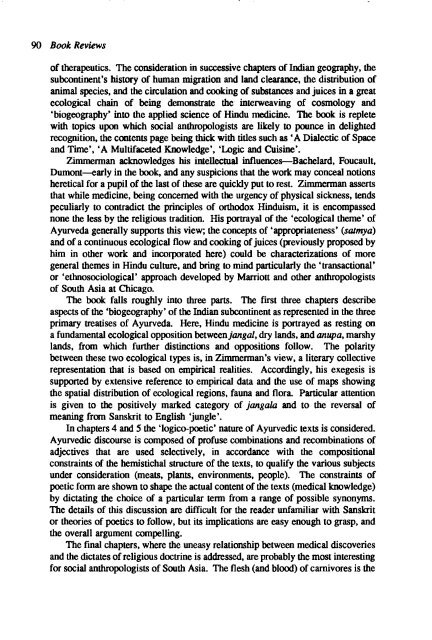1991 No. 1 CONTENTS - Institute of Social and Cultural ...
1991 No. 1 CONTENTS - Institute of Social and Cultural ...
1991 No. 1 CONTENTS - Institute of Social and Cultural ...
Create successful ePaper yourself
Turn your PDF publications into a flip-book with our unique Google optimized e-Paper software.
90 Book Reviews<br />
<strong>of</strong> therapeutics. The consideration in successive chapters <strong>of</strong> Indian geography, the<br />
subcontinent's history <strong>of</strong> human migration <strong>and</strong> l<strong>and</strong> clearance, the distribution <strong>of</strong><br />
animal species, <strong>and</strong> the circulation <strong>and</strong> cooking <strong>of</strong> substances <strong>and</strong> juices in a great<br />
ecological chain <strong>of</strong> being demonstrate the interweaving <strong>of</strong> cosmology <strong>and</strong><br />
'biogeography' into the applied science <strong>of</strong> Hindu medicine. The book is replete<br />
with topics upon which social anthropologists are likely to pounce in delighted<br />
recognition, the contents page being thick with titles such as 'A Dialectic <strong>of</strong> Space<br />
<strong>and</strong> Time', 'A Multifaceted Knowledge t, 'Logic <strong>and</strong> Cuisine'.<br />
Zimmerman acknowledges his intellectual influences--Bachelard, Foucault,<br />
Dumont-early in the book, <strong>and</strong> any suspicions that the work may conceal notions<br />
heretical for a pupil <strong>of</strong> the last <strong>of</strong> these are quickly put to rest. Zimmerman asserts<br />
that while medicine, being concerned with the urgency <strong>of</strong> physical sickness, tends<br />
peculiarly to contradict the principles <strong>of</strong> orthodox Hinduism, it is encompassed<br />
none the less by the religious tradition. His portrayal <strong>of</strong> the 'ecological theme' <strong>of</strong><br />
Ayurveda generally supports this view; the concepts <strong>of</strong> 'appropriateness' (salmya)<br />
<strong>and</strong> <strong>of</strong> a continuous ecological flow <strong>and</strong> cooking <strong>of</strong> juices (previously proposed by<br />
him in other work <strong>and</strong> incorporated here) could be characterizations <strong>of</strong> more<br />
general themes in Hindu culture, <strong>and</strong> bring to mind particularly the 'transactional'<br />
or 'ethnosociological' approach developed by Marriott <strong>and</strong> other anthropologists<br />
<strong>of</strong> South Asia at Chicago.<br />
The book: falls roughly into three parts. The fust three chapters describe<br />
as~ts <strong>of</strong> the 'biogeography' <strong>of</strong> the Indian subcontinent as represented in the three<br />
primary treatises <strong>of</strong> Ayurveda. Here, Hindu medicine is portrayed as resting on<br />
a fundamental ecological opposition betweenjangal, dry l<strong>and</strong>s, <strong>and</strong> anupa, marshy<br />
l<strong>and</strong>s, from which further distinctions <strong>and</strong> oppositions follow. The polarity<br />
between these two ecological types is, in Zimmerman's view, a literary collective<br />
representation that is based on empirical realities. Accordingly, his exegesis is<br />
supported by extensive reference to empirical data <strong>and</strong> the use <strong>of</strong> maps showing<br />
the spatial distribution <strong>of</strong> ecological regions, fauna <strong>and</strong> flora. Particular attention<br />
is given to the positively marked category <strong>of</strong> jangala <strong>and</strong> to the reversal <strong>of</strong><br />
meaning from Sanskrit to English 'jungle'.<br />
In chapters 4 <strong>and</strong> 5 the 'logico-poetic' nature <strong>of</strong> Ayurvedic texts is considered.<br />
Ayurvedic discourse is composed <strong>of</strong> pr<strong>of</strong>use combinations <strong>and</strong> recombinations <strong>of</strong><br />
adjectives that are used selectively, in accordance with the compositional<br />
constraints <strong>of</strong> the hemistichal structure <strong>of</strong> the texts, to qualify the various subjects<br />
under consideration (meats, plants, environments, people). The constraints <strong>of</strong><br />
poetic form are shown to shape the actual content <strong>of</strong> the texts (medical knowledge)<br />
by dictating the choice <strong>of</strong> a particular term from a range <strong>of</strong> possible synonyms.<br />
The details <strong>of</strong> this discussion are difficult for the reader unfamiliar with Sanskrit<br />
or theories <strong>of</strong> poetics to follow, but its implications are easy enough to grasp, <strong>and</strong><br />
the overall argument compelling.<br />
The fmal chapters, where the uneasy relationship between medical discoveries<br />
<strong>and</strong> the dictates <strong>of</strong> religious doctrine is addressed, are probably the most interesting<br />
for social anthropologists <strong>of</strong> South Asia. The flesh (<strong>and</strong> blood) <strong>of</strong> carnivores is the
















